Having benefitted from a succession of Australian head coaches, Yokohama F. Marinos saw it fit to once again embrace the trend and make Socceroos legend Harry Kewell their next manager at the beginning of the 2024 J1 League season.
Kewell was looking to put his poor managerial record behind him, seeking guidance from Marinos fan-favourite Ange Postecoglou in an attempt to bolster his coaching pedigree with a fresh start in Japan.
In some aspects, Kewell had outperformed some of the talented managers who came before him.
He guided Yokohama F. Marinos to their first-ever AFC Champions League final on the back of gritty performances when the odds were stacked against the Japanese club.
However, Kewell was unable to emulate the domestic success of Kevin Muscat and Ange Postecoglou.
Many suggested that their progression in the continental tournament had come at a detriment to their form in the J1 League.
Kewell was dismissed from his position, having guided the Marinos to the lows of 12th place.
For a club with such contrasting forms between the two competitions, the acceptance that the Marinos would be unable to challenge for domestic glory allowed tensions within the club to reach their boiling point, with club directors citing Kewell’s confusing tactical ideas as a main contributing factor.
This Harry Kewell tactical analysis will begin to highlight some of the structural problems that Yokohama F. Marinos have faced throughout this season, with the Australian unable to resolve their issues across the pitch.
Our analysis will shed light upon their tactics in and out of possession, with the Marinos’ dominant attacking identity being somewhat stifled under Kewell’s reign.
Marinos’ Tactical Identity
A lot has been said about continuing the Postecoglou legacy that has served the Marinos so well in recent years.
Kewell is also aiming to implement an attack-focused identity centred around determination and ball dominance.
This is evident when observing some of the underlying statistics, which begin to paint a picture of Marino’s tactical philosophies in Japan.
They average 60.5% possession in their bid to control as much of the play as possible.
Kewell has flirted with his formations this season, setting the Marinos up in a 4-2-3-1 on 34% of their matches whilst deploying the 4-3-3 30% of the time.
Unlike the 4-2-3-1, which features a double pivot to form a solid base in midfield, Kewell’s 4-3-3 has highlighted a lone pivot, which provides the freedom for their advanced number eights to support their forward line in the final third.
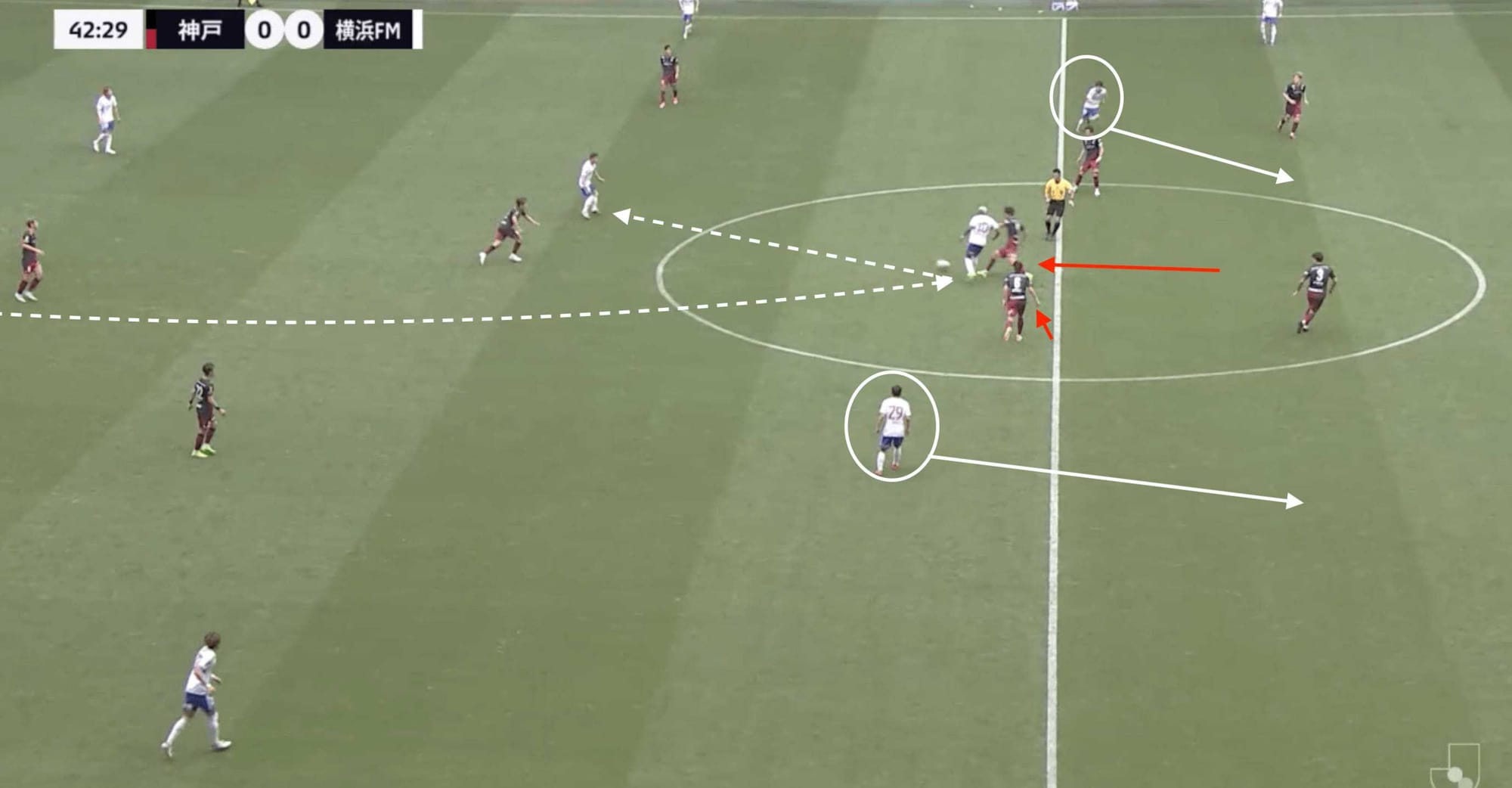
At times, they have possessed the spark to hurt any team in the J1 League.
Their progressive statistics highlight their ability to damage opponents with their attacking flair and the swiftness of their passing sequences.
Yokohama F. Marinos has achieved 57.3 passes into the final third per 90, accompanied by a 73.3% passing accuracy, which ranks them first and second in Japan, respectively.
The fact that they have also been able to possess 19.26 touches in the opponent’s penalty area would further press forward the notion that they have been a dominant side in the attacking third, but the reality of the matter has been much more concerning for fans of the Marinos.
Problems With Pressing
When it comes to pressing style, Yokohama F. Marinos have become synonymous with a high-intensity press effort, which stems from an engaged defensive line operating much further up the pitch.
Whilst not always such a crucial indicator of pressing success, the Marinos’ PPDA score of 8.35 would indicate that they are one of the most engaged pressors in all of Japan, something which was effectively transferred over to their efforts on the continental stage.
Kewell’s side’s ability to create high turnovers was one of the key contributors to their legendary run to the AFC Champions League final.
In the run-up to the final, they regained possession within 40 metres of the opposition’s goal on average 10.3 times per match.
In their biggest match of the season, facing Al Ain in the second leg of the final, it was their ability to capitalise on moments of error which allowed the Marinos to inject life into their attacking efforts, with the example below depicting Yan Matheus’ high press from their 4-2-3-1 defensive shape, dispossessing Kouame Autonne after a heavy touch.
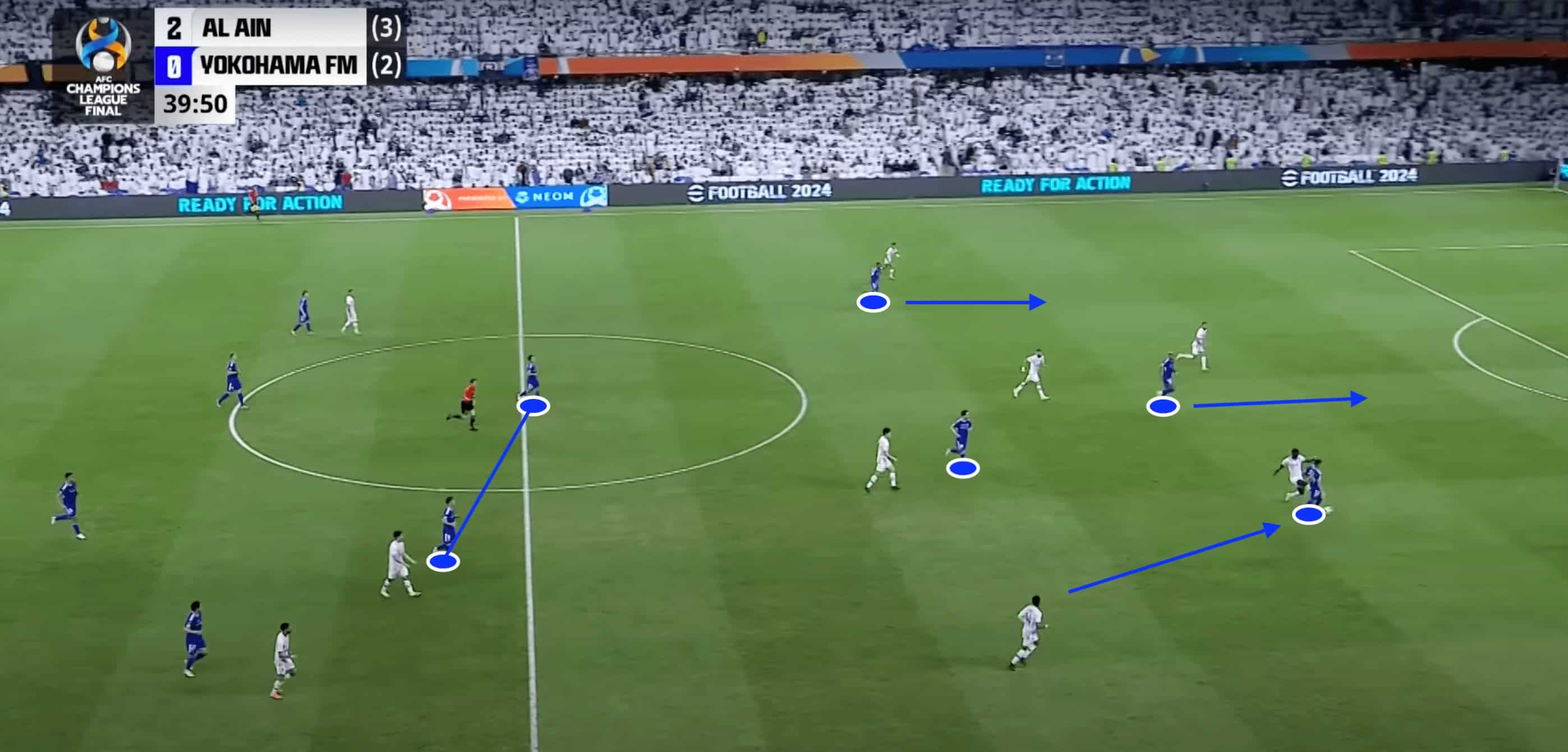
But these moments were far too infrequent for the fans’ liking when it came to performing in the J1 League, with the switch in formations often coming at a detriment to the Marinos’ structure when out of possession.
When taking on high-flying Machida Zelvia earlier in the season, we see the Marinos’ initial line of pressing comprised of Anderson Lopes and Jun Amano advancing in his role as a box-to-box midfielder.
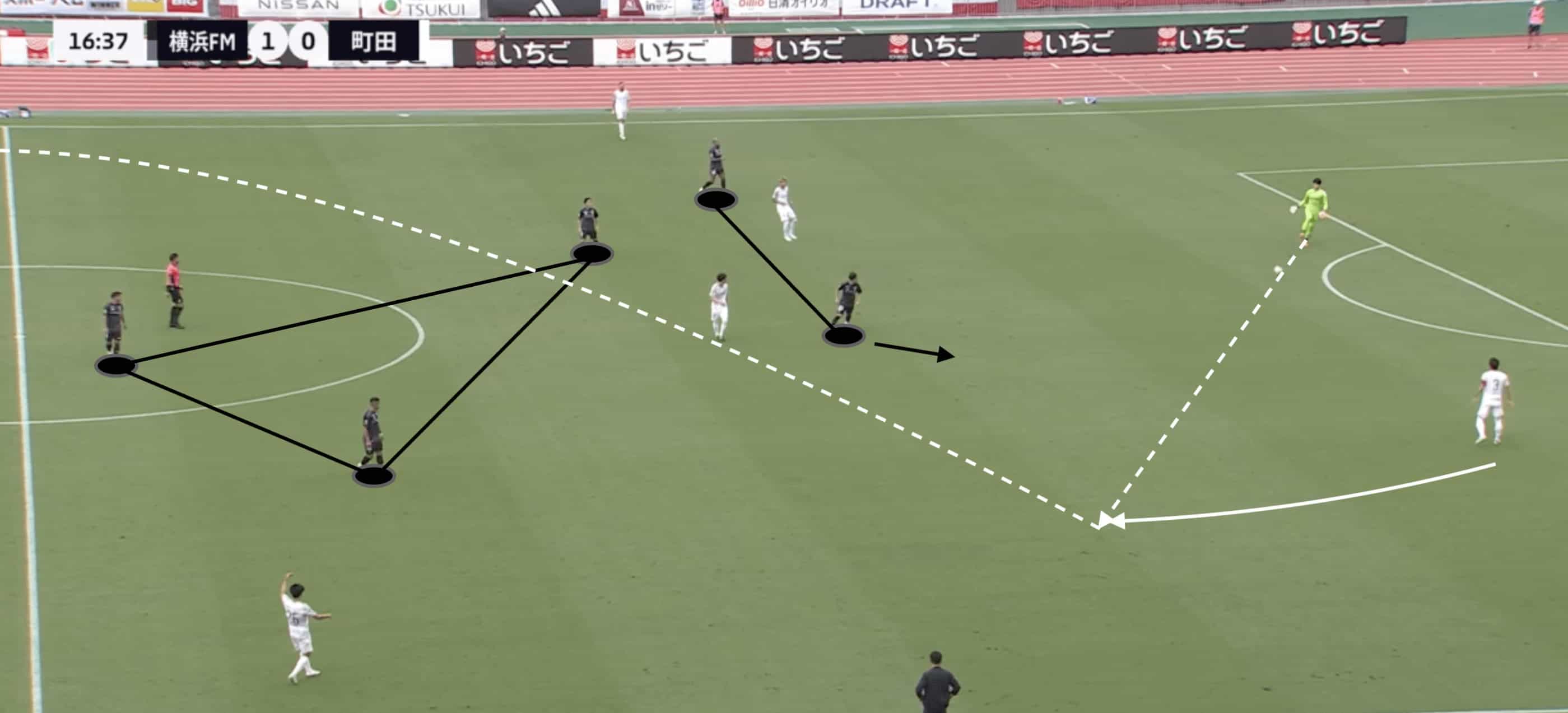
Behind them, we see an incredibly dysfunctional midfield line, which features Yan failing to be proactive on the right flank, along with a staggered pivot of Takuya Kida and Kota Watanabe ineffectively patrolling the middle of the pitch.
With Amano failing to get across and challenge the ball carrier, Gen Shoji was able to launch a devastating diagonal ball across to the right flank, providing Machida Zelvia with an excellent opportunity to run at the Marinos defensive line.
These moments emphasise the speed at which teams have been able to carve open Kewell’s defensive structure when effort levels are not at their absolute maximum.
PPDA statistics cannot necessarily highlight the ease at which the Marinos allow their opposition to march up the pitch.
Defensive Deficiency
The pressing efforts of Yokohama F. Marinos only scratch the surface of the wider defensive issues that they face each match.
The Japanese powerhouses are marred by mistakes within their own third and an overall decline in their defensive stature.
Whilst the fact that William Popp has struggled in the Marinos’ goal, it certainly doesn’t help that they have suffered the third most shots in the J1 League, facing 12.52 on average per match.
This defensive pressure is compounded by the fact that Kewell’s team have been awful when it comes to their defensive engagements, ranking 18th and 20th for defensive duel rate (49.71 per 90) and defensive duel success percentage (55.3%), respectively.
It was metrics like these which hadn’t changed too much from the days of Muscat and Postecoglou.
Still, Kewell’s predecessors were able to efficiently mask such problems with their overall dominance and ability to blow the opposition away.
Unfortunately for Kewell, in an attempt to perhaps overcompensate for their weaker press, we see the Marinos becoming overly eager in their pressing efforts, creating moments of vulnerability in transition.
In their match against Kashima Antlers, we see an incredibly committed pressing effort when anticipating the opposition’s throw-in, with all three Marinos midfielders within the Kashima half, accompanied by the onrushing central defender, Takumi Kamijima.
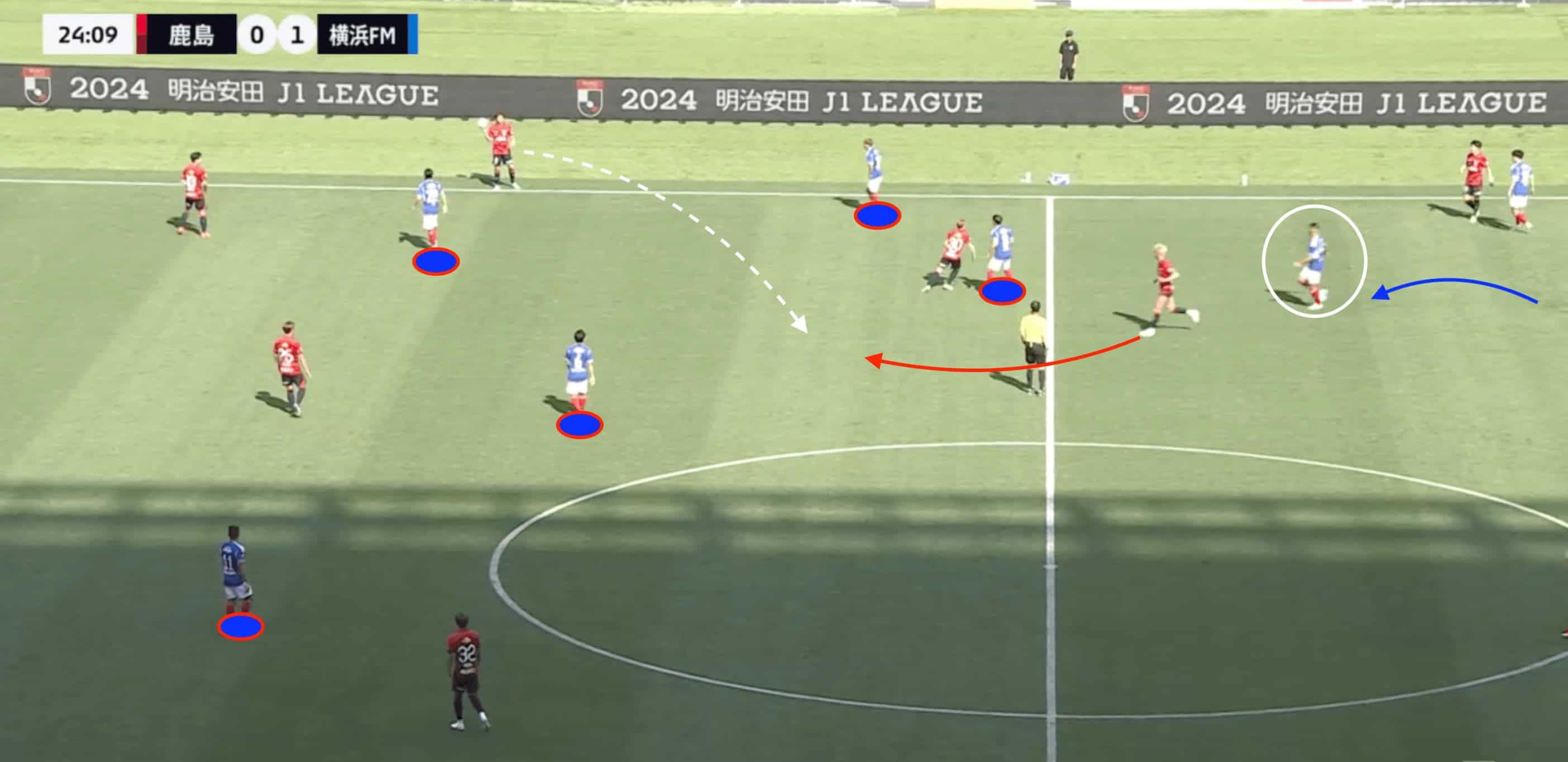
Consequently, this weakened the Marinos’ defensive line, and Kamijima’s intervention was to no avail.
This allowed a huge pocket of space for the Kashima midfielder to exploit, carrying the ball into the final third.
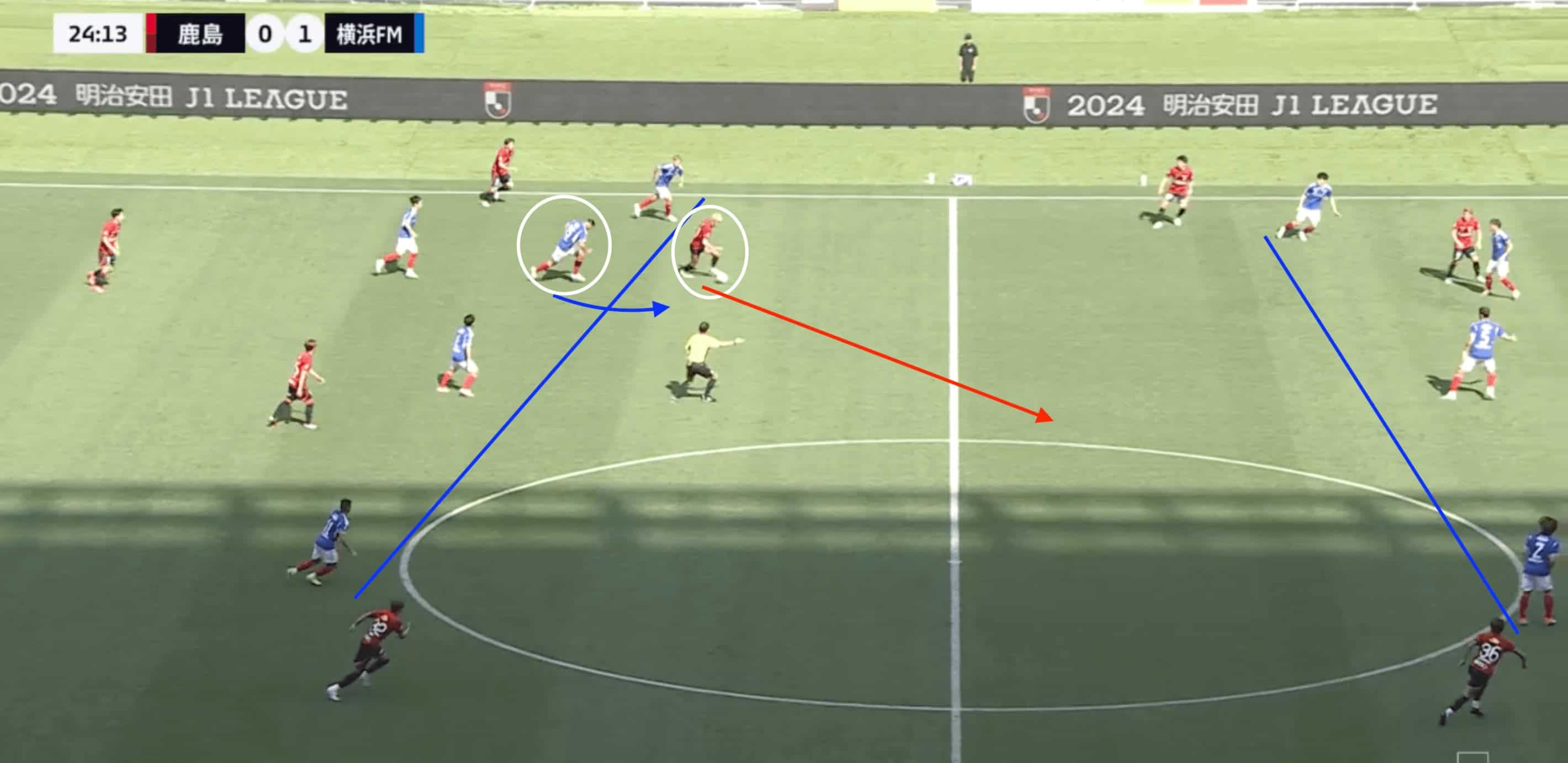
It is largely from counter-attacking scenarios where Kewell’s defensive structure has been all over the place, perfectly portrayed in their 5-1 defeat to Al Ain.
When giving the ball away cheaply in the middle of the pitch, we see a narrowed makeshift defensive line as a result of the two Marinos full-backs operating higher up the pitch in anticipation of their team’s progression.
This eventually culminates in an excellent opportunity for Al Ain to assert their attacking dominance in the match.
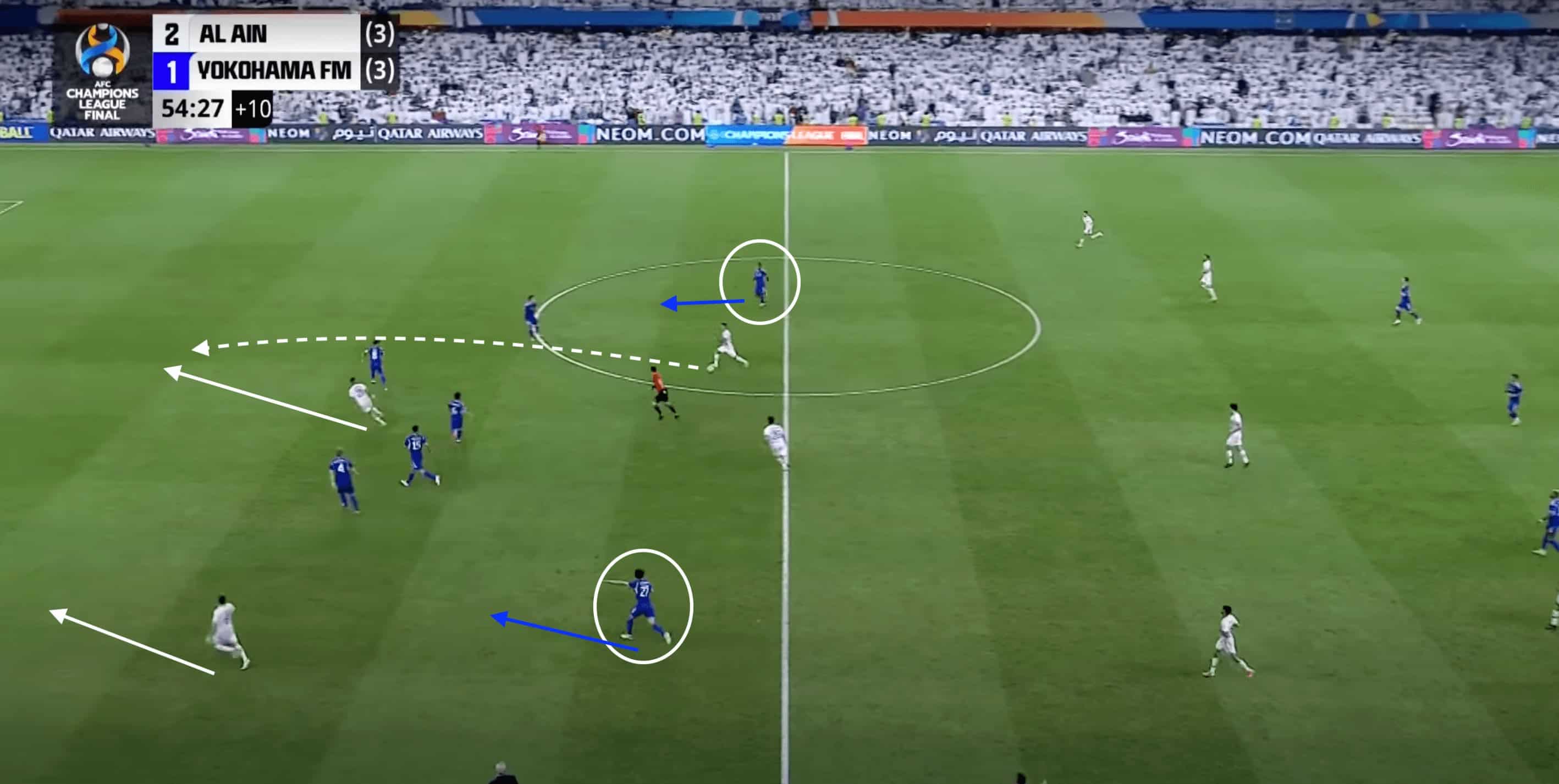
It begs the question as to whether the current crop of Marinos’s defensive players have the ability to match the club’s high-energy defensive intentions, having decreased in quality since the Postecoglou days and subsequently struggling to maintain their level of defensive overachievement.
Misfiring Up Front
Having earlier touched on the fact that Yokohama F. Marinos have had little trouble progressing the ball into the final third, it is their conversion in front of goal which was the most alarming factor throughout Kewell’s tenure.
On the surface, the Marinos have been able to complete the second-highest number of shots per match (13.0) across the J1 League, but their shots-on-target accuracy (33.7%) is much more representative of their current league position, comfortably in and around the middle of the table.
An overall conversion rate of around 9% in both domestic and continental competition would suggest that Yokohama F. Marinos have lacked their usual conviction, but also been on the wrong end of some attacking misfortune; as opposed to their ability to better their expected goals figure in 2022 and 2023.
The ability to generate high turnovers is definitely essential for this team, but if they are unable to lead to a consistent stream of meaningful chances, is it something that can be categorised as a resounding strength?
On their journey to the AFC Champions League final, their 124 high turnovers trumped the figures of their closest competitors, but only 23 of these instances ended in a shooting opportunity, and just one singular goal stemmed from their ability to regain possession high up the pitch.
An over-reliance on star striker Anderson Lopes has left the Marinos helpless when the Brazilian is misfiring.
His 14 goals are by far the most throughout the present season.
Crucially for the Marinos, even Lopes, in his current goalscoring form, has emulated the lack of composure that has plagued their season.
The star Brazilian is still in a deficit of -6.55 when comparing his actual goal contributions to his xG.
The present example will help to visualise how Yokohama F. Marinos lacked the ruthless attacking nature which helped them to be so successful not so long ago.
Having caught Sagan Tosu as they look to reshape after an attacking set-piece, the Marinos are able to break quickly with Lopes striding into the opposition half, destined for a high-percentage attacking opportunity with minimal defensive resistance.

What actually occurred was a much more laboured attacking sequence, which lacked the necessary invention to hurt the Sagan Tosu defence.
This ultimately resulted in Lopes lacking in ball coordination and resorting to a frustrated kick into touch as defensive personnel flooded the penalty area.
The Marinos’ poor conversion rate can also be attributed to their increased frequency of shots from outside the penalty area (163, which is the second highest in the J League).
As shown here with Lopes guiding their attacking sequence, the long-range efforts are not always the most optimal choices when breaking into the final third, but it begins to highlight their struggles when attempting to craft better chances when trying to make use of their penalty area possession.
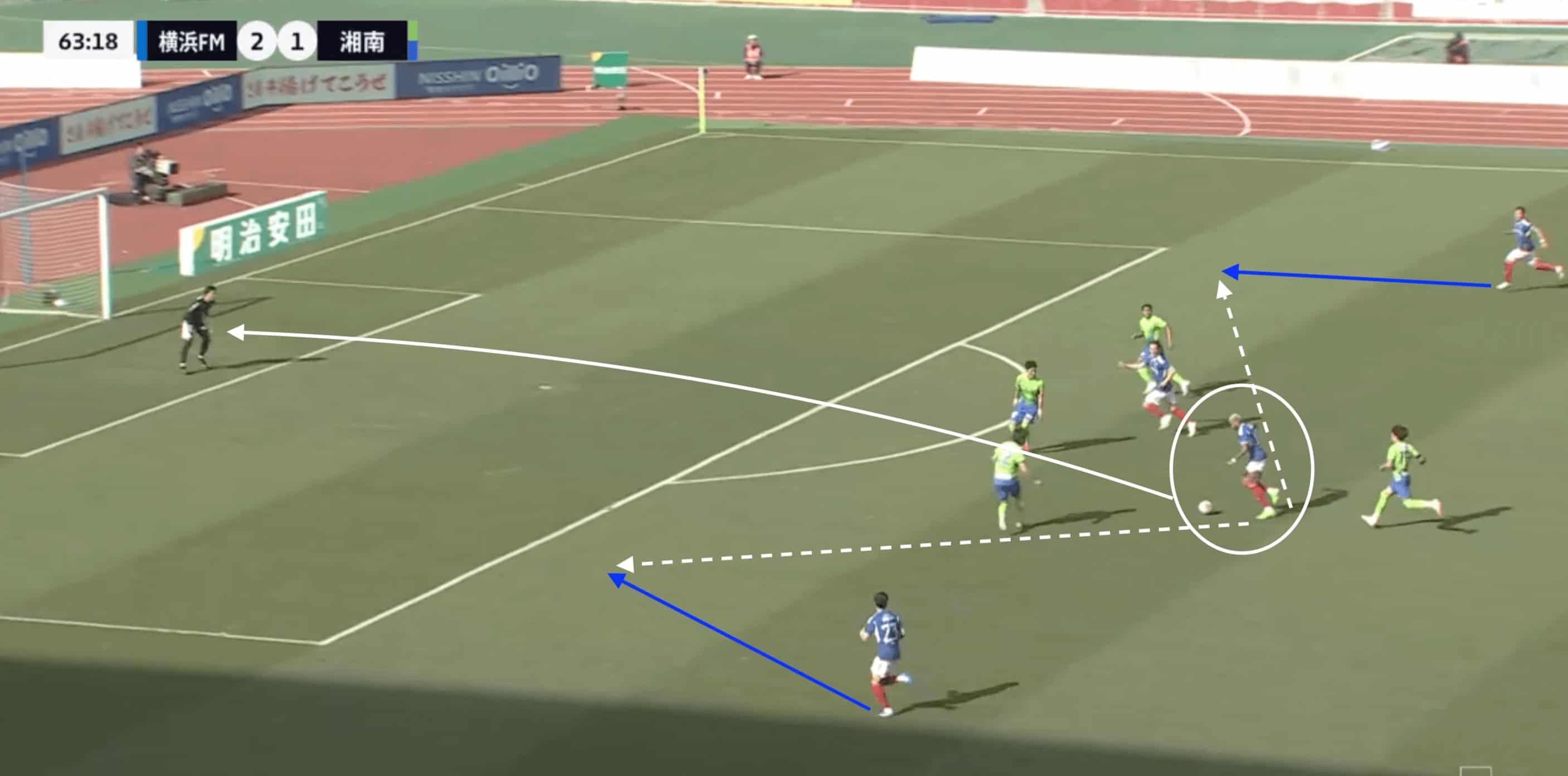
Conclusion
As Kewell’s tenure drew to a close, it sparked mixed reactions as to whether his sacking was fair, citing his valiant run in the Champions League as a potential reason why he could be trusted to take Yokohama F. Marinos out of this troublesome spell.
But for all his successes when battling for Asian glory, the trouncing at the hands of Al Ain further damaged his reputation and left fans of the Marinos wishing for the good times to return.





Comments